Bernard O’Kane’s sumptuous book is a true publishing tour de force, combining unrivaled subject expertise and photographic talent.
all images Courtesy The Mosques of Egypt (AUC Press)
Some months ago, I wrote an article for this column that concentrated on what many consider to be one of the most serene and spiritual spaces in the whole of Egypt—
the Mosque of Ibn Tulun. This month, I have been reading more about Ibn Tulun, and more than eighty other mosques around Egypt, in a new publication:
The Mosques of Egypt by Bernard O’Kane. The book is sumptuous—a true publishing tour de force combining the unrivaled subject expertise and photographic talent of the author, and the best in editorial and production values.
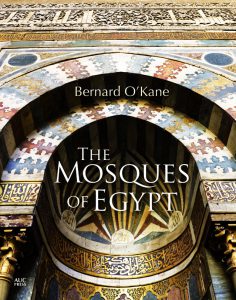
One of the main themes of the book is the diversity of architectural forms that can be discerned in Egyptian mosques—from the founding of the first mosque in Egypt, that of ‘Amr ibn al-‘As, to rather less aesthetically pleasing modern efforts. Historically, this diversity seems to have been a product of the requirement to perform the pilgrimage to Mecca, which facilitated the transmission of artistic in-novation across the region.
Partly because I love the area around Fustat and ‘Old Cairo’, I have something of a soft spot for the Mosque of ‘Amr (founded in 641—just two years after the Muslims arrived in Egypt—and the first mosque in Africa). Little of the extant mosque dates before the nineteenth century, and, indeed, the original mosque was no more than a small rectangular building some fifteen by twenty-five meters. A courtyard was added in 673, and the building was extended to its current roughly square form in 827. Despite the relative modernity of the visible structure in comparison to its place in history, the rows of arcades around the courtyard on every side remain attractive.
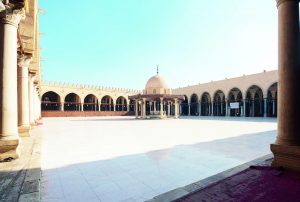
The courtyard, Mosque of ‘Amr, Cairo
Something of an oasis of calm amidst the chaos outside, the Mosque of al-Azhar (originally constructed between 970-972) is, similarly, most notable in my mind for the beautiful stucco work added to the courtyard by the Fatimid caliph al Hafiz (1129-49), and as, of course, a very long-standing educational institution. As I am not an architectural historian, I tend to keep my eyes at the courtyard level as I find the number of highly decorated minarets around the courtyard jarring, though I recognize them, and other features, as symbolic of the central importance of the mosque in Cairo’s history, and as representations of the many novel design features which were either imported into Egypt or homegrown over the centuries.
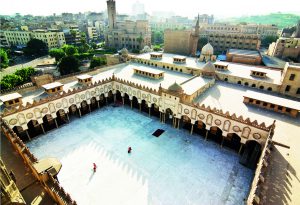
Mosque of al-Azhar, Cairo
It is not possible in twelve hundred words to do anything more than offer you a sample from this fascinating volume. How can one not mention any one of a number of the great mosques of Cairo—including the grand funerary complexes of sultans Hasan (built 1356-61), Barquq (1384-86), and Faraj ibn Barquq (1400-11); or the lovely lantern over the courtyard in the considerably less massive, but more harmonious, complex of Qijmas al-Ishaqi (1479-82); or the Iznik tiles—even if they are not quite the best examples—that the Ottoman amir Ibrahim Pasha utilized in his mid-seventeenth restoration of the complex of Aqsunqur (1346); or the door of the Qala’t al-Kabsh mosque of Sultan Qaytbay (1475)—another personal favorite; or, indeed, the spectacular imperial Ottoman-style Mosque of Muhammad ‘Ali (1831-1857), which dominates the area surrounding the Citadel and beyond?
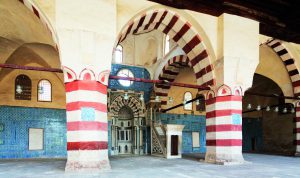
Qibla wall and Iznik tiles, complex of Aqsunqur, Cairo
Yet regular readers of this column will not be surprised to hear that I want to leave Cairo behind for a moment and travel to Luxor.
In 1325, a rather more famous traveler, Ibn Battuta, passed through Luxor on the way to Mecca. He made no mention of the ancient Egyptian temple, but de-scribed instead the tomb and zawiya (in this context, a small structure in which a Sufi lived) of Yusuf ibn ‘Abd al-Rahim al-Qurashi, known as Abu’l Hajjaj.
At least in part, the reason why Ibn Battuta did not mention the great temple is that only the very tops of the ancient structure showed above the sand. There was a nine meter difference in height be-tween the ground level of the shrine and the temple (which was not completely excavated until 1884). One of the most pleasing views in the temple is to look up at the shrine hanging somewhat incongruously above the temple.
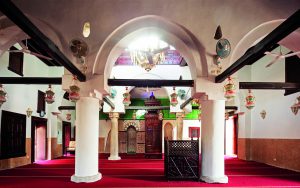
Shrine of Abu’l-Hajjaj, Luxor
More importantly, however, Abu’l Haj-jaj, who had travelled from Baghdad to Mecca, and made Luxor his home on his return, was so well respected for his sanctity that many people came to the city to meet him. He was, it is thought, over ninety when he died in 1244, and he was buried in his zawiya. His son constructed a mausoleum over the tomb in 1257 and built the small mosque—on the remains of an older church—together with a minaret, which seems today to balance the nearby ancient obelisk.
The sense that the building had almost grown organically from the underlying temple is reinforced by the niche to the right of the minbar (pulpit) that is carved into one of the temple’s original columns. Interestingly, the mulid, or saint’s day, of Abu’l-Hajjaj is also well known for its procession of boats, which may echo the pharaonic past.
Across the river from Luxor, and across quite a few centuries too, the famed architect Hassan Fathy—about whose work AUC Press will shortly be publishing a new book—designed the congregational mosque (1945-48) and village of New Gourna. The village, which was built with the expressed intention of discouraging its new inhabitants from their deeply historic occupation of tomb looting, has had a checkered history, but the mosque itself remains well kept. Although the modern tendency has shifted somewhat to criticize Fathy for his single-minded concentration on Nubian vernacular forms, and rejection of modern materials, these are the very characteristics that I find attractive in his work.
Even though the original villagers did not take well to Fathy’s large-scale use of domes—something they associated with funerary buildings—there can be no doubt of the sense of calm and simplicity that characterize the congregational mosque.
Yet, there is also something of a sense of playfulness in the asymmetry of this mod-ern building that recalls the sometimes rather odd relationships between the out-er walls of medieval Cairene mosques and what would have been the haphazardly laid-out streets outside.
Having done so at length before in these pages, I have done my best not to talk about the great Mosque of Ibn Tulun (876- 79)—the last remaining vestige of the ‘lost city’ of al-Qata’i’, but, as I end this piece, I can no longer resist temptation.

Arcade, Mosque of Ibn Tulun, Cairo
Indeed, even Fathy’s deceptively plain and modern Gourna mosque echoes, in its dome, the chamber for ablutions built by the Mamluk amir Lajin in 1296 at the center of the courtyard of the great mosque which rises from the Cairene bed-rock and, in its turn, and in its original form, echoed the ‘Abbasid mosques of Samarra—including the helicoidal form of its original stone minaret (also replaced under amir Lajin), of which it was said that two fully-laden camels could climb side by side to the top.
Although much altered over the years, the Mosque of Ibn Tulun always lives up to its reputation as one of the great architectural masterpieces of the world. A simple glance through the arches of the arcades cannot fail to bring, as was always intended, no doubt, a sense of peace.
Nigel Fletcher-Jones is director of the American University in Cairo Press. Join Nigel on Facebook and browse AUC’s list of stores at aucpress.com.


 Mosque of al-Azhar, Cairo
Mosque of al-Azhar, Cairo
 Qibla wall and Iznik tiles, complex of Aqsunqur, Cairo
Qibla wall and Iznik tiles, complex of Aqsunqur, Cairo
 Shrine of Abu’l-Hajjaj, Luxor
Shrine of Abu’l-Hajjaj, Luxor
 Arcade, Mosque of Ibn Tulun, Cairo
Arcade, Mosque of Ibn Tulun, Cairo
Comments
Leave a Comment